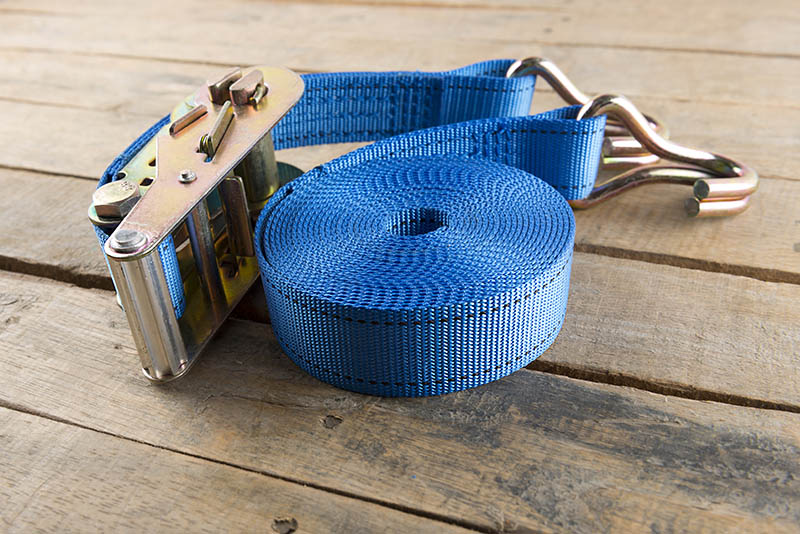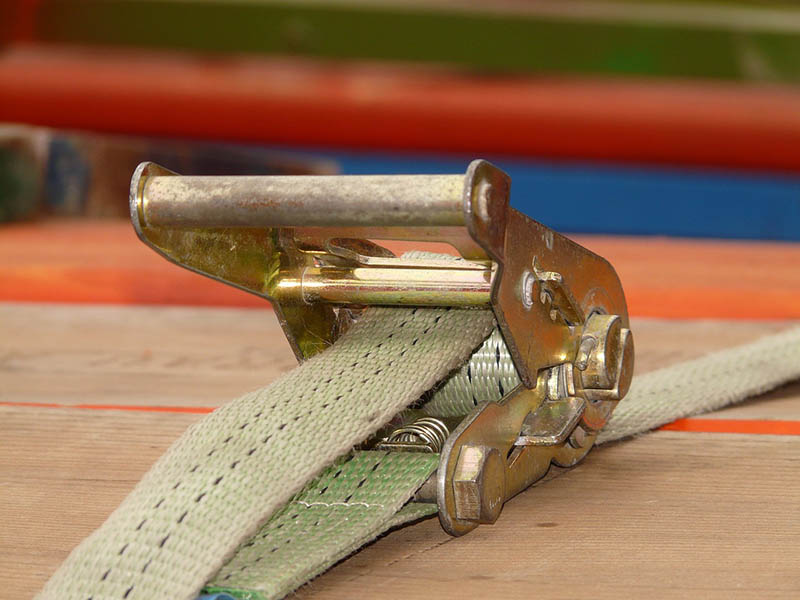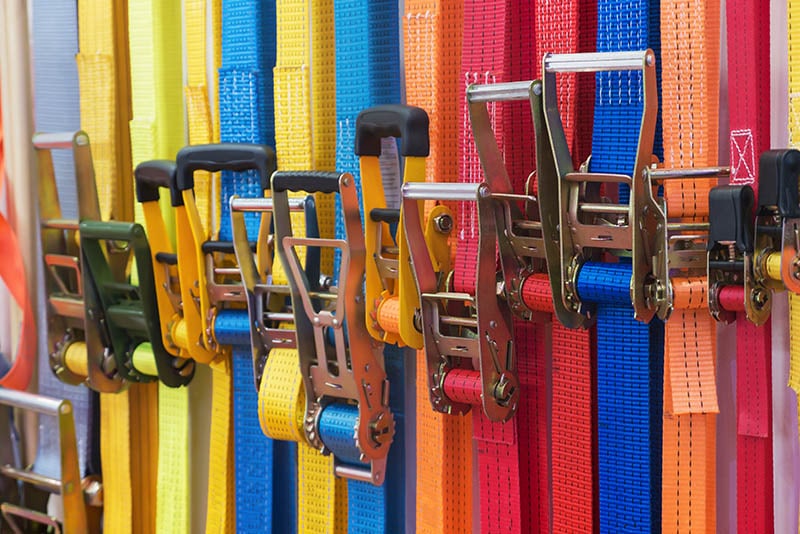5 Great Tips on How to Store Ratchet Straps — You Need to Know!
-
Pete Ortiz
- Last updated:

Those in the transportation industry know how vital ratchet straps are. Whether for long-distance cargo or even a one-time activity involving moving house furniture from one home to another, you need ratchet straps that are still in good condition to hold the luggage in place during transportation.
Even though ratchet straps are a huge part of transporting goods and a great safety measure, not many know how to store them correctly. Luckily, in this article, we cover ideas on what to do before storing ratchet straps and how to store them safely so they can serve you longer. Keep reading for a deeper insight.
Before Storing Ratchet Straps: Preparations
First, you need to identify an ideal storage location. Ratchet straps must be stored in a dry environment with no moisture and away from direct sunlight. The location should not be anywhere close to a source of water or heat. Suppose you can’t get such a space, purchase a waterproof or duffle bag or use an extra toolbox from your garage to keep the ratchet straps safe.
Secondly, inspect the ratchet straps before storage, every time you are done using them and whenever you intend to use them. This minimizes the chances of the ratchet straps getting damaged when in use. Also, it is essential to identify any situation on the straps that may cause doubt about their strength or ability to be used for the intended purpose.
When conducting your regular scrutiny, look out for signs like:
- Missing tags
- Cuts or tears
- Worn-out or broken stitches
- Corrosion to buckles and end fittings
- Excessive tear of the webbing part
- Burns caused by an acid or welding splatter during minor repairs

The 5 Ways to Store Ratchet Straps
Proper storage of ratchet traps will reduce the mess, create more space in your working area, and make it easy for you to identify the kind of ratchet strap you need for a specific task.
You can put your ratchet straps away using any of the methods described below.
1. Consider a Proper Arrangement of the Ratchet Straps
For easier accessibility and organization, you need a neat method to store the ratchet strap. Occasionally, rolling them is the best way to ensure they are neatly arranged or organized.
The rolling does not need to be neat; just thread the end of the strap through the opening where it is attached to a buckle. Depending on the length of the strap ratchet, pull it through and simply continue rolling as you ensure it is tight.
Secondly, apart from rolling them, you may also use rubber bands or socks to separate your ratchet straps while keeping them well organized.
2. Tie Them Together
As you consider safe storage of your ratchet straps, you may begin by tying them up together to avoid messy situations. You may tie ratchet straps made of various webbings together depending on their use. However, remember not to put too many of them together; you may have issues with the knotting process. Here are some tying materials to use:
- Duct tape: You can use duct tape to tie together different types of ratchet straps used for various purposes. Apart from helping you organize your ratchet straps, they are also easy to remove each time you are in a hurry to use them.
- Rubber bands: As mentioned earlier, using rubber bands is one way to ensure that your ratchet straps are neatly arranged for easy visibility. They play the same role as a storage method and are cheap and readily available. However, due to the type of texture the webbing of the ratchet strap is made of, you may want to consider getting yourself a box of thick rubber bands.
- Cable ties: Cable ties have certain similarities to zip ties. They can also be used to secure ratchet straps into a bundle. They are perfect for securing ratchet straps since they are long-lasting, and unlike zip ties, they are easily adjustable. You can also reuse them more than once.
- Ball bungee cord: Ball bungee cords come in various sizes; therefore, they can be used to tie various ratchet straps together. They are durable and more flexible to use than other methods, like rubber bands and cable ties. You can reuse ball bungee cords as many times as you wish if they are still in perfect condition.
3. Store in a Ziplock Bag
Apart from all other known ways of using a Ziplock bag, storing ratchet straps is another advantage of purchasing these bags. Before storing the ratchet straps in the bag, ensure they are secured with a rubber band, cable tie, or duct tape to avoid entanglement. Alternatively, you may roll the ratchet straps into a coil so that they can easily fit in the bag. You can store several ratchet straps in one Ziplock bag.
4. Store Ratchet Straps in a Plastic Sheet Wrap
A plastic sheet wrap falls under one of the most organized ways you can store a ratchet strap. You simply roll the ratchet straps and wrap them up in the plastic sheet. Unlike other methods, plastic sheet wrap can be reused again if only you handle them carefully.
5. Use a Plastic Storage Box
A plastic storage box is suitable for storing ratchet straps since it helps protect them from sharp objects that may damage their webbing. It also protects the ratchet straps from a wet or moist environment that can interfere with the texture of the straps.
However, secure the ratchet straps so you do not just toss them carelessly into the box. Also, the plastic box can easily be stacked on a shelf or any other secure place away from the site to make your space more organized.
Tips to Consider for Proper Storage of Ratchet Straps
Ratchet straps should last up to four years when used regularly on heavy duty. However, improper storage techniques can reduce this lifespan. Below are some tips to consider for proper storage.

Do Not Expose the Ratchet Straps to Too Much Sunlight
Ratchet straps are made from 100% polyester, a heavy and strong material that can withstand repeated use for quite a long time. However, despite being so strong, sunlight is among the most significant weaknesses polyester materials have.
When exposed to sunlight, after a while, the UV light rays begin to weaken and break down the fiber. Eventually, the straps become brittle and discolored. It is challenging to work with ratchet straps whose fiber has been extremely affected by sunlight to the point that they have a brittle texture; such ratchet straps often end up snapping during the process of use.
To be safe, ensure that you store your straps in a translucent material away from direct sunlight.
Avoid Storing Wet Ratchet Straps
After a long day of work on a rainy day, do not attempt to store your ratchet straps while still wet, especially if you do not intend to use them for a while. The same way sunlight harms the straps is the same way moisture or water will destroy them.
When you store your ratchet straps in their wet state, you create a conducive environment for rapid mold and mildew growth. The mold will damage the texture of the ratchet straps’ webbing part, eventually weakening them and causing them to break suddenly when in use.
Avoid Friction
The main reason why we need a storage technique for ratchet straps is that we don’t want to leave them hanging or facing constant rubbing against a surface.
Avoid placing your ratchet strap against a moving part or surface that may cause friction, as this will lead to the weakening and wearing out of the ratchet strap webbing parts.
How Ratchet Straps Are Used
There are two essential factors to consider when handling ratchet straps. The first factor is inspecting the ratchet straps and ensuring they are in good condition for storage, as already stated above. The second factor is how to use them.
When using a ratchet strap, pick the loose end and insert it into the ratchet’s mandrel, and pull it tightly to hold the luggage tightly in place to avoid tangling while transporting your goods. When done, lock down the handle.
When it is time to release the ratchet strap, pull the trigger or the handle backward to open it. The webbing will begin to feel less and less tight; therefore, pull it through the ratchet’s mandrel to release your luggage. When done, close the ratchet.
Conclusion
To maximize the longevity of your ratchet straps, you must exercise proper storage whenever they are not in use. Identify a dry storage location away from sunlight. Also, consider arranging them in an orderly manner, after which you can tie them using ropes, duct tape, cable ties, rubber bands, or ball bungee cords.
You can then store your neatly arranged and tied straps in a Ziplock bag, plastic sheet wrap, or a plastic storage box.
Proper storage is not always enough; other methods can also be used to ensure the ratchet straps last longer. For instance, avoid storing wet straps. Also, remember to shield your ratchet straps from friction when in storage.
Featured Image Credit: imoooun, Shutterstock
Contents



